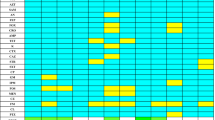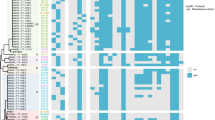Abstract
Objectives
Urinary tract infection (UTI) is one of the most common extraintestinal infections, and uropathogenic Escherichia coli (UPEC) is the main cause of UTIs. However, the ability to treat UTI has been compromised by the increase in antimicrobial resistance, especially carbapenem resistance. Here, we aimed to characterize the antimicrobial resistance and molecular epidemiology of carbapenem-resistant UPEC isolated in Shandong, China.
Methods
In total, 17 carbapenem-resistant UPEC (CR-UPEC) isolates were collected from July 2017 to May 2020 in the Shandong Provincial Hospital. Whole-genome sequencing and bioinformatics analyses were performed to understand the molecular epidemiology of CR-UPEC. Phylogenetic groups, drug resistance genes, biofilm formation, and virulence-related gene profiles of the isolates were analyzed. Plasmid profiling and conjugation assay were performed to evaluate the ability to transfer carbapenem resistance-related genes to other E. coli isolates. Biofilm formation was also evaluated, as it is important for the persistence of infectious diseases.
Results
We observed that 15 out of 17 CR-UPEC strains were blaNDM producers, among which 4 isolates could transfer blaNDM to recipient cells. The predominant sequence type was ST167 (6/17), followed by ST410 (3/17). The most prevalent phylogenetic group was phylogenetic group A (10/17), followed by phylogenetic group C (3/17). One isolate was resistant to polymyxin, which was caused by the carriage of a transferable plasmid harboring mcr-1. Statistical analysis did not reveal any significant difference in the carriage rate of fimbriae-coding genes between strong and weak biofilm producers.
Conclusions
Our observations may assist in developing new therapeutic methods for drug-resistant organisms.





Similar content being viewed by others
Data availability
The data presented in this study are available on reasonable request from the corresponding author.
References
Abd El Ghany M et al (2018) Genomic characterization of NDM-1 and 5, and OXA-181 carbapenemases in uropathogenic Escherichia coli isolates from Riyadh. Saudi Arabia Plos One 13:e0201613
Chen J et al (2019) Molecular Epidemiology of Plasmid-Mediated Fosfomycin Resistance Gene Determinants in Klebsiella pneumoniae Carbapenemase-Producing Klebsiella pneumoniae Isolates in China. Microb Drug Resist 25:251–257
Chen F et al (2021) Clinical Characteristics of Patients and Whole Genome Sequencing-Based Surveillance of Escherichia coli Community-Onset Bloodstream Infections at a Non-tertiary Hospital in CHINA. Front Microbiol 12:748471
CLSI (2020) Performance standards for antimicrobial susceptibility testing document M100, 30th edn. Clinical and Laboratory Standards Institute, Wayne, PA
Dadashi M et al (2019) Frequency distribution, genotypes and prevalent sequence types of New Delhi metallo-beta-lactamase-producing Escherichia coli among clinical isolates around the world: A review. J Glob Antimicrob Resist 19:284–293
Doi Y (2019) Treatment Options for Carbapenem-resistant Gram-negative Bacterial Infections. Clin Infect Dis 69:S565–S575
European Committee on Antimicrobial Susceptibility Testing (2020) Breakpoint tables for interpretation of MICs and zone diameters version 10.0. http://www.eucast.org/fileadmin/src/media/PDFs/EUCAST_files/Breakpoint_tables/v_10.0_Breakpoint_Tables.pdf
Heras J et al (2015) GelJ–a tool for analyzing DNA fingerprint gel images. BMC Bioinformatics 16:270
Kot B (2019) Antibiotic Resistance Among Uropathogenic Escherichia coli. Pol J Microbiol 68:403–415
Kucheria R et al (2005) Urinary tract infections: new insights into a common problem. Postgrad Med J 81:83–86
Li F et al (2021) Genetic characterization of Carbapenem-Resistant Escherichia coli from China, 2015–2017. BMC Microbiol 21:248
Polemis M, Tryfinopoulou K, Giakkoupi P, Vatopoulos A (2020) Eight-year trends in the relative isolation frequency and antimicrobial susceptibility among bloodstream isolates from Greek hospitals: data from the Greek Electronic System for the Surveillance of Antimicrobial Resistance - WHONET-Greece, 2010 to 2017. [Journal Article; Observational Study]. Euro Surveill 25(34). https://doi.org/10.2807/1560-7917.ES.2020.25.34.1900516
Sun P et al (2019) Characterization Of bla (NDM-5)-Positive Escherichia coli Prevalent In A University Hospital In Eastern China. Infect Drug Resist 12:3029–3038
Wang M et al (2020) A Clinical Extensively-Drug Resistant (XDR) Escherichia coli and Role of Its beta-Lactamase Genes. Front Microbiol 11:590357
Wu B et al (2020) Detection of microbial aerosols in hospital wards and molecular identification and dissemination of drug resistance of Escherichia coli. Environ Int 137:105479
Zamani H, Salehzadeh A (2018) Biofilm formation in uropathogenic Escherichia coli: association with adhesion factor genes. Turk J Med Sci 48:162–167
Zangane Matin F et al (2021) Virulence characterization and clonal analysis of uropathogenic Escherichia coli metallo-beta-lactamase-producing isolates. Ann Clin Microbiol Antimicrob 20:50
Zhang R et al (2017) Nationwide Surveillance of Clinical Carbapenem-resistant Enterobacteriaceae (CRE) Strains in China. EBioMedicine 19:98–106
Zhang Y, Wang Q, Yin Y, Chen H, Jin L, Gu B, ... Wang H (2018) Epidemiology of carbapenem-resistant enterobacteriaceae infections: report from the China CRE network. Antimicrob Agents Chemother 62(2). https://doi.org/10.1128/AAC.01882-17
Zhang W et al (2021) Clinical Distribution Characteristics of 1439 Carbapenem-Resistant Escherichia coli Strains in China: Drug Resistance, Geographical Distribution, Antibiotic MIC50/90. Infect Drug Resist 14:4717–4725
Acknowledgements
We thank Zhiming Lu for the help and support.
Funding
The study was supported by grants from National Natural Science Foundation of China (81902119) and Shandong Province Natural Science Fundation (ZR2020MH306).
Author information
Authors and Affiliations
Contributions
Yingying Hao contributed to experiment conception and design. Ran Chen and Guili Wang conducted bioinformatics analysis and the wrote the paper.Yueling Wang,Yuanyuan Bai and Zhen Song performed data analysis. Zhongkun Wan and Meng Zhang carried out the bacteria identification. Zaigeng Si,Xinglun Lu and Qian Wang prepared the Tables and figures. The corresponding author is responsible for submitting a competing interests statement on behalf of all authors of the paper.
Corresponding author
Ethics declarations
Competing interests
The authors declare no competing interests.
Ethics approval and consent to participate
Not applicable.
Consent for publication
All authors have read and agreed to the published version of the manuscript.
Conflict of interest
the authors declare that the research was conducted in the absence of any commercial or financial relationships that could be construed as a potential conflict of interest.
Additional information
Publisher's note
Springer Nature remains neutral with regard to jurisdictional claims in published maps and institutional affiliations.
Supplementary Information
Below is the link to the electronic supplementary material.
Rights and permissions
Springer Nature or its licensor (e.g. a society or other partner) holds exclusive rights to this article under a publishing agreement with the author(s) or other rightsholder(s); author self-archiving of the accepted manuscript version of this article is solely governed by the terms of such publishing agreement and applicable law.
About this article
Cite this article
Chen, R., Wang, G., Wang, Q. et al. Antimicrobial resistance and molecular epidemiology of carbapenem-resistant Escherichia coli from urinary tract infections in Shandong, China. Int Microbiol 26, 1157–1166 (2023). https://doi.org/10.1007/s10123-023-00369-7
Received:
Revised:
Accepted:
Published:
Issue Date:
DOI: https://doi.org/10.1007/s10123-023-00369-7




